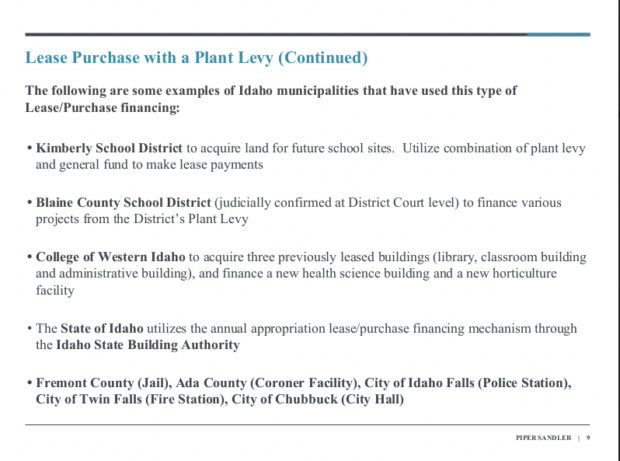When districts put bonds on the ballot in hopes of financing one or more new schools, the chances of voter approval in Idaho are 50/50: a coin toss.
If districts lose, the problems that sparked the ballot initiative — overcrowding, outdated schools, safety concerns — don’t go away.
So district leaders make do with their cracked foundations and outdoor food storage. They might seek creative but short-term solutions, like redrawn boundaries or modular classrooms. Hallways, principal’s offices and lunchrooms might become classrooms.
Or leaders might hang their hopes on a new solution: a plant facilities levy.
The plant facilities levy’s voter approval thresholds — which can be as low as 55% — make them attractive, but there are drawbacks. Districts might have to downsize their project list or eschew state financial help if they opt for this route.
School leaders are already familiar with plant facilities levies; they’re often used for repairs, maintenance, or upgrades. But when it comes to new construction, these ballot measures are a relatively new option, one districts have historically been reluctant to pursue due to murky legality. But that changed when a 2015 Idaho Supreme Court decision upheld the practice.
For some districts, it’s now the most enticing and likely path to new schools.
On Monday, West Ada School District began public discussion about putting a 10-year, $500 million plant facilities levy on the ballot in May. And, after a record $250-million bond failure, the Idaho Falls School District is considering running its own 10-year, $32.5 million plant facilities levy to fund a new elementary school.
In West Ada, packed classes, potholes in hallways, and safety concerns are among the issues driving the plant facilities levy talks.
“It’s amazing to see the deterioration in some of these schools,” Lori Frasure, chair of the West Ada School Board, said at a regular board meeting on Monday. “It’s definitely clear that something needs to be done.”
As more districts consider turning to plant facilities levies, it’s important to understand how they work and what they mean for taxpayers.
For an explainer on bonds and levies, go here.
Plant facilities levy breakdown: benefits and downsides to districts
Since 2000, only 52% of proposed school bonds have passed. That’s partly because of the 66 and two-thirds supermajority needed to pass bonds — one of the highest required pass rates in the nation.
As one Idaho superintendent put it, it only takes about 33 percent of voters to fail a bond.
And it’s unlikely that legislators will lower that supermajority threshold – many such failed attempts have been made.
But, plant facilities levies could offer districts a path to new buildings without that high voter approval rate. Depending on how much the district is asking for, the approval rate could be as low as 55%. That rate can stair-step up to 60% or a supermajority depending on the amount of money a district is requesting.
So — one downside to plant facilities levies — districts may have to cross some items off their wish lists to keep price tags down.
For example, the Idaho Falls School District had originally hoped for two new elementary schools, a new high school, and extensive upgrades to an existing high school. Now, if it puts a plant facilities levy on the ballot, it will be asking for just a new elementary school.
Pared-down project lists aren’t the only downside.
Districts who opt for this route also lose out on the chance to get state financial assistance via the bond and levy equalization program. In 2022, 55 of 72 districts with bonds were benefiting from that program. If a district would qualify for that assistance, a plant facilities levy might not be worth the losses.
How a plant facilities levy impacts a taxpayer’s pocketbook
A plant facilities levy can evade supermajority approval because it technically doesn’t put the district in debt. In theory, a district can walk away from a given construction project at any time.
Nick Miller, an attorney for Hawley Troxell, said it’s like a lease-to-own program: a district leases a newly-constructed building for 10 years. After that time period, the district owns the building.
A plant facilities levy would mean taxpayers are paying for a new building over 10 years as opposed to 20 or 30, as is often the case with bonds.
On Monday, Jonathan Gillen, West Ada’s chief operations officer, used a mortgage analogy to explain the new option to trustees: a bond is like a 30-year mortgage and a plant facilities levy would be like a 15-year mortgage.
With a plant facilities levy, taxpayers would shell out more each month. However, in the long term, it would be cheaper because taxpayers aren’t paying off interest that accumulates over decades.
A case study: comparing a plant facilities levy to a bond
Here’s a detailed look at what a plant facilities levy, used for new construction, would mean for taxpayers — using West Ada’s proposal as a case study.
To start, the slide below (a screenshot from a presentation to West Ada trustees) offers a side-by-side comparison of the two options:
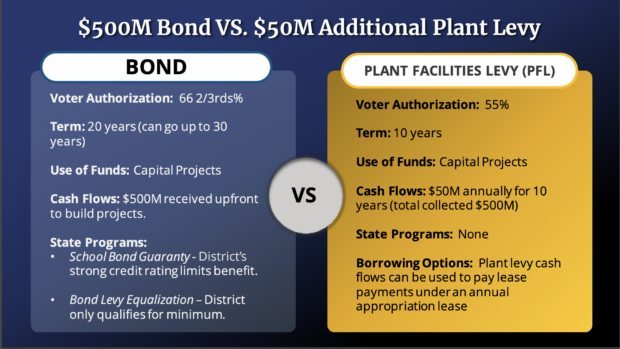
This next slide dives into the details, and will show that over time, the $500 million bond would cost taxpayers an additional $255.3 million. However, the $500 million levy option would cost taxpayers an extra $21/per $100,000 of their home’s taxable market value each year.
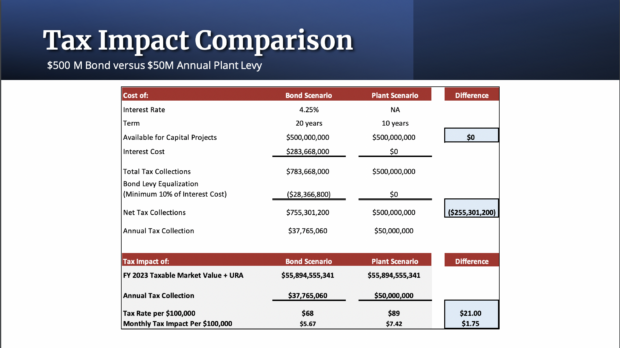
If you take into account the average home value in the Meridian area, which is about $535,000, the bond would cost most homeowners about $2,000 more in the long run, as the slide below demonstrates. But, homeowners would be paying an extra $7 per month with a plant facilities levy.
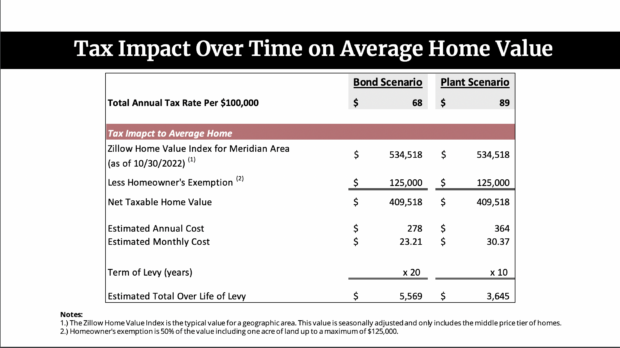
That $7 can be a lot for some families, Trustee David Binetti pointed out at the meeting.
“I want to be clear: that’s important and that makes a difference to people,” he said.
At any district, one of the biggest differences between a levy and bond approach is that funds from plant facilities levies are collected annually over ten years. Bond funds come as one big payment.
Next steps for West Ada: potentially putting this $500-million levy on the May ballot
After the presentation, Frasure said she was in favor of the plant levy.
“We have an opportunity with this situation to be in front of the aging needs and … have some flexibility that we have not had in the past,” she said.
If the district does put the levy on the May ballot (that decision is scheduled to be made by the board on Feb. 27), and the ballot passes, the funds would be used for two new elementary schools, a new CTE center, and maintenance, repairs, renovations and expansions throughout the district. A full list of those proposed projects can be seen on slides 23-27 of this presentation.
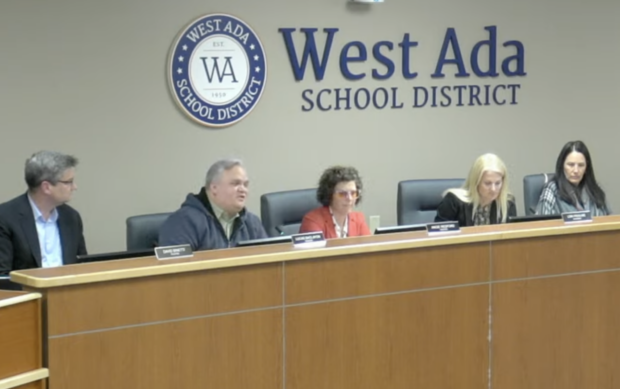
The Idaho Falls School District is still holding discussions on whether to propose its plant facilities levy.
If the districts do so, it wouldn’t be the first time a plant facilities levy has been used for new school construction or purchases. The slide below, prepared by Piper Sandler and presented to Idaho Falls trustees, shows that the Kimberly and Blaine County school districts have done so previously.
